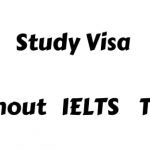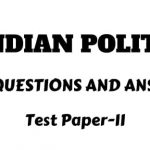Indian Polity and Constitution
Test Paper I
Learn Indian Polity and constitution for Civil Services Examination, SSC, Group I, Group II and Railways examination with MCQ question and answer, Get complete 60 practice Test papers ebook from Fdaytalk ebooks
50 MCQ Practice MCQ Questions
1) In which year India national congress (INC), officially demanded constituent assembly?
a) 1935
b) 1937
c) 1945
d) 1955
Ans: a) 1935
2) What is the August offer of 1940?
a) British government accepting of framing a constituent assembly
b) British government accepting of freedom to India
c) British government accepting of Muslim league
d) British government accepting of the cabinet mission plan
Ans: British government accepting of framing a constituent assembly
3) Who came to India to draft an independent constitution?
a) Warren hasting
b) Lord Cornwallis
c) Sir Stafford Cripps
d) Lord Minto
Ans: c) sir Stafford Cripps
4) Constituent assembly constituted in November 1946 by?
a) Joh shore
b) Cabinet mission plan
c) Cabinet mission organization
d) Cabinet committee
Ans: Cabinet mission plan
5) Total strength of constituent assembly is 389, of them?
a) 279 seats of British India and 94 of princely states
b) 298 seats of British India and 93 of princely states
c) 296 seats of British India and 93 of princely states
d) 300 seats of British India and 89 of princely states
Ans: 296 seats for British India and 93 of princely states
6) Election to the constituent assembly for 296 seats held in July -August 1946?
a) INC won 208 seats
b) Muslim league won 73 seats
c) Independents won 15 seats
d) All the above
Ans: d) All the above
7) 1st Meeting of constituent assembly held on?
a) 10 Dec; 1946
b) 9 Dec; 1946
c) 8 Dec; 1946
d) 7 Dec; 1946
Ans: 9 Dec; 1946
8) Who were the first President & Vice President of the constituent assembly?
a) HC Mukherjee & Dr. Rajendra Prasad
b) HC Mukherjee & Dr. Satchidananda Sinha
C) Satchidananda Sinha & HC Mukherjee
D) Dr Rajendra Prasad & HC Mukherjee
Ans: Dr. Rajendra Prasad & HC Mukherjee
9) Who the constitutional advisor to constituent assembly?
a) BN Rau
b) HC Mukherjee
c) BN Prasad
D) None of the above
Ans: a) BN Rau
10) Jawaharlal Nehru moved an objective resolution in constituent assembly on 13 Dec 1946, which was unanimously adopted on ?
a) 26 Jan 1947
b) 27 Jan 1947
c) 28 Jan 1947
d) 22 Jan 1947
Ans: d) 22 Jan 1947
11) Constituent assembly performed the following functions
a) Ratified India membership in the commonwealth in May 1949
b) Adopted National Flag on July 22, 1947
c) Adopted National Anthem on Jan 24, 1950
d) Adopted National song on Jan 24, 1950
e) Elected 1st president of India on Jan 24, 1950
f) All the above
Ans: f) All the above
Note: 1st president of India: Dr. Rajendra Prasad
12) Constituent assembly worked for
a) 11 sessions for 2yrs, 11 months, 18 days
b) 12 sessions for 2yrs; 11 months; 18 days
c) 13 sessions for 2yrs; 11months; 18 days
d) 14 sessions for 2yrs; 11months; 18 days
Ans: a) 11 sessions for 2yrs; 11 months, 18 days
13) Final Session Of Constituent Assembly Held On
A) 24 Dec 1950
b) 24 Nov, 1950
c) 24 Jan 1950
c) 24 Feb. 1950
Ans: c) 24 Jan 1950
14) 1st general election in India held on
A) 1950-51
b) 1951-52
c) 1947-78
d) 1948-50
Ans: b) 1951-52
15) Match the following?
a) Union power committee 1) BR Ambedkar
b) Provincial constitution committee 2) Jawaharlal Nehru
c) Drafting committee 3) JB Kripalani
d) Steering committee 4) Dr. Rajendra Prasad
5) Sadar Patel
a) 2, 1, 5, 4
b) 1, 2, 5, 4
c) 2, 5, 1, 4
d) 2, 5, 4, 1
Ans: 2, 5, 1, 4
16) Important committee & heads
a) Union constitution committee – Jawaharlal Nehru
b) Fundamental rights subcommittee – JB Kripalani
c) Minorities subcommittee – HC Mukheerjee
d) States committee – Jawaharlal Nehru
17) Committee & heads
a) committee on functions of constituent assembly- G.V Mavalankar
b) House committee- B. Pattabhi Sitaramayya
c) Ad-hoc committee on National flag- Rajendra Prasad
d) Special committee to examine draft constitution- Alladi Krishna Swamy Ayyar
18) Drafting committee headed by BR AMBEDKAR, constituted in
a) 29 Aug 1947
b) 30 Aug 1948
c) 19 Aug 1948
d) 30 Aug 1949
Ans: 29 Aug 1947
19) Seven members of the drafting committee?
a) B.R Ambedkar- Chairman
b) N Gopalaswamy Ayyangar
c) Alladi Krishnaswamy Ayyar
d) K.M Munshi
e) Syed Mohammad Saadullah
f) N. Madhava Rao – Replaced by B L Mitter
g) T T Krishnamachari – Replaced by D P Khaitan
20) Indian constitution was adopted on 26th Nov 1949 with
a) Preamble, 400 Articles and 8 schedules
b) Preamble, 396 Articles and 8 schedules
c) Preamble, 395 Articles and 8 schedules
d) Preamble,400 Articles and 7 schedules
Ans: Preamble, 395 Articles and 8 schedules
21) Who is known as “Father of the constitution of India?
a) B.R Ambedkar
b) Jawaharlal Nehru
c) Gandhi
d) Sardar Patel
Ans: a) B.R Ambedkar
22) Constitution of India came into force on?
a) 26 Jan 1950
b) 27 Jan 1960
c) 25 Jan 1950
d)15 Aug 1947
Ans: a) 26 Jan 1950
23) When Purna swaraj day was celebrated?
a) 26 Jan 1950
b) 26 Jan 1930
c) 26 Jan 1948
d) 26 Jan 1947
Ans: 26 Jan 1930
24) Member of cabinet mission
a) Lord Patrick Lawrence
b) Sir Stafford Cripps
c) AV Alexander
d) All the above
Ans: d) All the above
25) Constituent assembly met as_____ on Nov 17, 1947 and elected GV Mavalankar as Speaker.
a) Legislature
b) Union legislature
c) Dominion legislature
d) None of these
Ans: c) Dominion legislature
26) Which amendment is known as Mini-constitution?
a) 73rd Amendment
b) 44th Amendment
c) 7th Amendment
d) 42nd Amendment
Ans: d) 42nd Amendment
27) Constitution of India originally contained
a) Preamble, 395 articles (divided into 22 parts) and 8 schedules
b) Preamble, 380 articles (divided into 22 parts) and 8 schedules
c) Preamble, 450 articles (divided into 22 parts) and 8 schedules
d) Preamble, 450 articles (divided into 22 parts) and 12 schedules
Ans: a) Preamble, 395 articles (divided into 22 parts) and 8 schedules
28) At present, the constitution of India contained
a) preamble, 450 articles (divided into 24 parts) and 12 schedules
b) Preamble, 400 articles (divided into 24 parts) and 12 schedules
c) Preamble, 350 articles (divided into 24 parts) and 12 schedules
d) Preamble, 300 articles (divided into 24 parts) and 12 schedules
Ans: a) Preamble, 450 articles (divided into 24 parts) and 12 schedules
29) The parliamentary system is based on principle of
a) Cooperation and coordination between legislative and executive
b) Cooperation and coordination between union and centre
c) Separation and power between legislative and executive
d) Separation and power between union to centre
Ans: a) Cooperation and coordination between legislative and executive
30) Presidential system is based on?
a) Cooperation of coordination between legislative and executive
b) Cooperation of coordination between union and centre
c) Separation of power between legislative and executive
d) Separation of power between union to centre
Ans: c) Separation of power between legislative and executive
31) Features of parliamentary government in India
a) Presence of nominal and real executives
b) Majority party rule
c) Collective responsibility of the executive to the legislature
d) Prime minister & Chief minister
e) Dissolution of lower house ( Lok Sabha or Assembly)
f) All the above
Ans: f) All the above
32) Part III of the Indian constitution guarantees how many number of fundamental rights to citizens
a) 6
b) 7
c) 8
d) 9
Ans: 6
33) In constitution of India, right to equality are of
a) Article 19 to 18
b) Article 21 to 24
c) Article 14 to 18
d) Article 25 to 30
Ans: c) Article 14 to 18
34) In constitution of India, right to freedom are of
a) Article 19 to 18
b) Article 19 to 22
c) Article 14 to 18
d) Article 25 to 30
Ans: b) Article 19 to 22
35) In constitution of India, Right against exploitation are of
a) Article 23 to 24
b) Article 19 to 22
c) Article 22 to 25
d) Article 23 to 25
Ans: a) Article 23 to 24
36) In constitution of India, Right to freedom of religion are of
a) Article 25 to 29
b) Article 25 to 28
c) Article 22 to 25
d) Article 23 to 25
Ans: b) Article 25 to 28
37) In Constitution of India, cultural & educational rights are of
a) Article 29 to 30
b) Article 30 to 32
c) Article 22 to 25
d) Article 23 to 25
Ans: a) Article 29 to 30
38) In the constitution of India; the right to constitutional remedies is?
a) Article 326
b) Article 32
c) Article 44
d) Article 123
Ans: Article 32
39) For the restoration of fundamental rights, the supreme court can issue writs of?
a) Habeas corpus
b) Mandamus
c) Prohibition
d) Certiorari
e) Quo warranto
f) All the above
Ans: f) All the above
40) According to BR Ambedkar, the directive principles of state policy are?
a) Novel feature
b) Socialistic features
c) Gandhian features
d) None of the above
Ans: Novel feature
41) Fundamental duties were added during internal emergency 1975-77 by
a) 44th amendment
b) 42nd amendment
c) 76th amendment
d) 41st amendment
Ans: 42nd amendment
42) Fundamental duties were added on the recommendation of?
a) Swaran sigh committee
b) Manmohan sigh committee
c) Kumara Singha committee
d) None of the above
Ans: Swaran sigh committee
43) The term secular was added to preamble by
a) 44th amendment, 1976
b) 42nd amendment, 1976
c) 76th amendment, 1976
d) 86th amendment, 1976
Ans: 42nd amendment, 1976
44) By which amendment, the voting age was reduced to 18 yrs from 21 yrs in 1989
a) 66th amendment
b) 65th amendment
c) 61th amendment
d) 60th amendment
Ans: c) 61th amendment
45) Emergency provision in the constitution of India
a) National emergency on ground of war
b) National emergency on external aggression or armed rebellion
c) State emergency
d) Financial emergency
e) All the above
Ans: e) All the above
46) Which article mentions about national emergency?
A) Article 351
b) Article 352
c) Article 356
d) Article 360
Ans: b) Article 352
47) Which Article Mentions About State’s Emergency?
A) Article 365 & Article 365
B) Article 351 & Article 321
C) Article 451 & Article 256
D) Article 261 & Article 360
Ans: A) Article 365 & Article 365
48) Which article mentions about financial emergency?
a) Article365
b) Article 354
c) Article 361
d) Article 360
Ans: d) Article 360
49) By which amendment, internal disturbance term is replaced with armed rebellion?
a) 42nd amendment
b) 44th Amendment
c) 76th amendment
d) 88thanmendment
Ans: 44th amendment
50) Part 9 of the Indian constitution provides _____, which were added by 73rd amendment
a) Panchayat raj system
b) Nagar panchayats raj system
c) Both
d) None
Ans: a) Panchayat raj system
Get More, 60+ Practice Test Paper of Indian Polity and constitution from below links
Learn More

